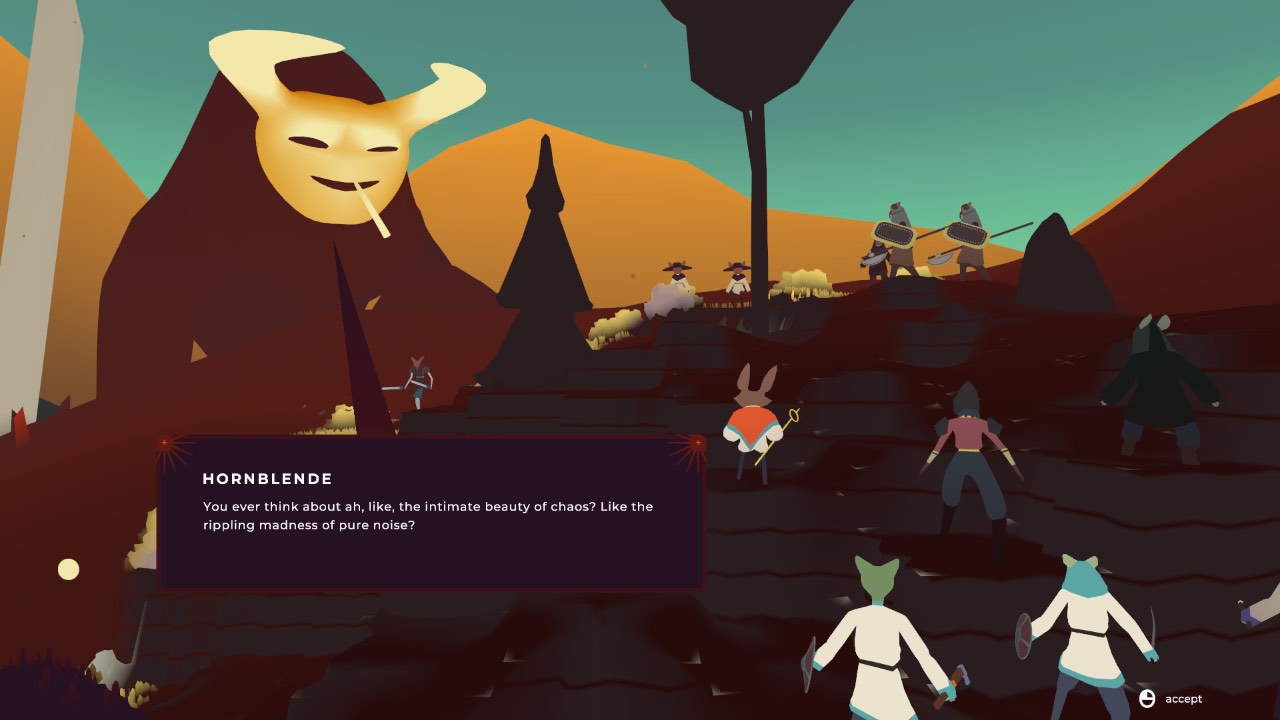There’s an arresting tension at the heart of Tenderfoot Tactics. This is a game where you break from precise, deterministic turn-based combat to explore an overworld both immaterial and tangibly evocative, leading to a tension between touch and sense memory, between foggy truth and lucid dreams.
Between combat and exploration, you’ll trade out the hard lines of movement grids and AOE markers for loose, impressionistic hand-drawn-maps. You’ll break from non-random hit percentages and precise, immutable damage numbers to soak up cryptic hints and desperate, seeking tone poems opined by puppet-weaving spirits that tower above forest and town.
Sometimes, the combat’s determinism becomes formulaic, and its frequency repetitious. That lack of direction might start to feel like hopelessness occasionally, but then the immaterial skyline will flutter, the archipelago will reveal another secret, and that hopelessness will start to feel like…not hope, exactly. It’s more that sweet, stranded feeling that at least knows there’s more sights worth seeing, if only you’ll pace on into the fog.

Tenderfoot’s atmosphere eludes easy comparison, but I do love a crutch, so here goes: Tenderfoot Tactics is Breath of the Wild meets Final Fantasy Tactics, with the terrain manipulation of Divinity Original Sin 2. This description is the roundest of pegs, awkwardly jammed into Tenderfoot’s psychedelic-splat shaped hole, but it’ll have to do.
You play as an entity controlling a gang of goblins. You’ll walk, slide, jump and sail over the archipelago, uncovering the mysteries of each island. All enemy encounters can be seen on the overworld, giving you a chance to avoid them if you wish. There are also special encounters, which give you a choice whether to engage or not. Occasionally, you’ll encounter a settlement, where you can trade the items you gather from combat, mix items, and chat to some of the townsfolk for tantalising fragments of lore.
You’ll soon fill out your squad of six goblins, and the game then becomes about discovering new job classes, combining job classes, levelling up, and learning new abilities. They start off with simple classes like ranged and melee, then upgrade to knights, archers, and spellcasters, and onward to classes that require multiclass experience. To become a battlemage, a goblin will need to train in both knight and spellcaster classes. It’s a varied, customisable system that finds various ways for later classes to use abilities from earlier ones, allowing for a huge amount of tinkering and tailoring to your liking.

Taking for granted that combat features genre staples like grid-based movement, movement and action allowances, and fixed turn order, what sets it apart? Firstly, the way you can mess with that turn order through affecting individual units’ morale – either through the use of certain abilities, or attacking them from the side or back. Next, there’s the environment. Most abilities feature some sort of elemental affinity, and this can morph the terrain in individual grid squares – from creating steep hills to hinder movement, to setting dry grass on fire.
There’s no initiative system, as far as I can tell, which means the starting order is random. You move your goblins around before a match starts, though, adjusting both turn order and grid positions, though the actual turn sequence stays the same. The problem here is that you can just ‘restart scum’ until you get a turn order you’re happy with, which is admittedly cheap, but can be hard to resist.
Also, you can sometimes insult other goblins to death, which is great.

In lieu of trying and failing to do Tenderfoot Tactics’ OST justice with language – as fun as that might be – you can listen to it here on Bandcamp. It’s a playful yet somber accompaniment to the way the game’s environs ebb and flow in and out of reality. A good battle soundtrack should make fights feel significant – and these dynamic, reactive stems certainly do – but it also makes standing atop a hill staring at the horizon feel just as momentous. Regardless of context, ‘Goblin Town: Stinkhorn Central’ is a certified banger.

